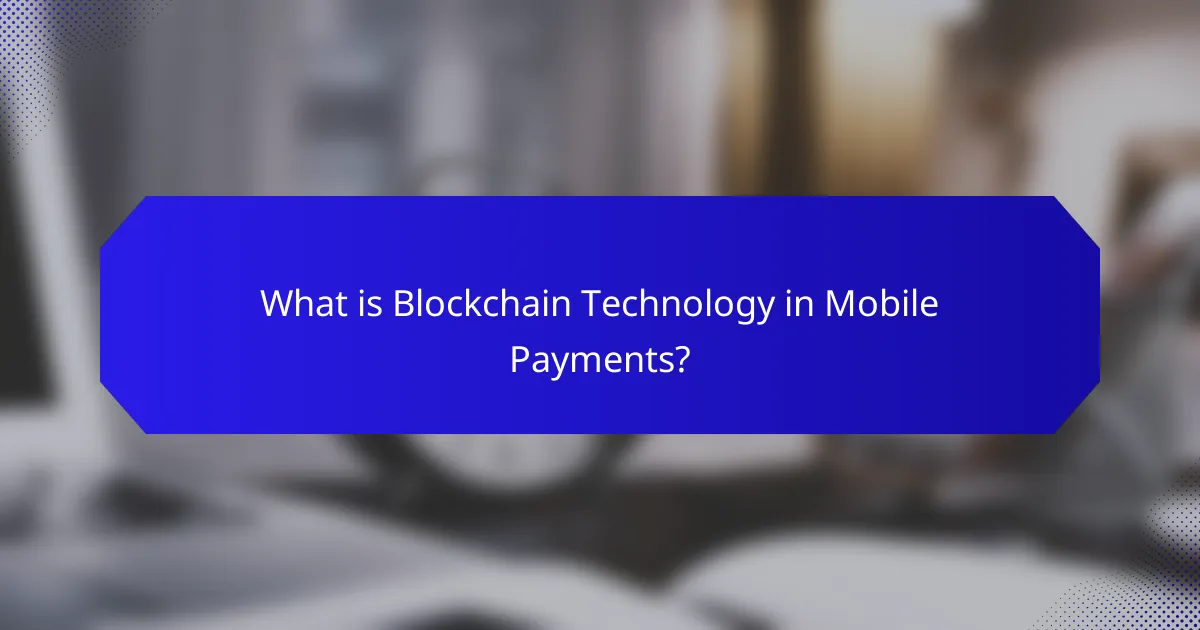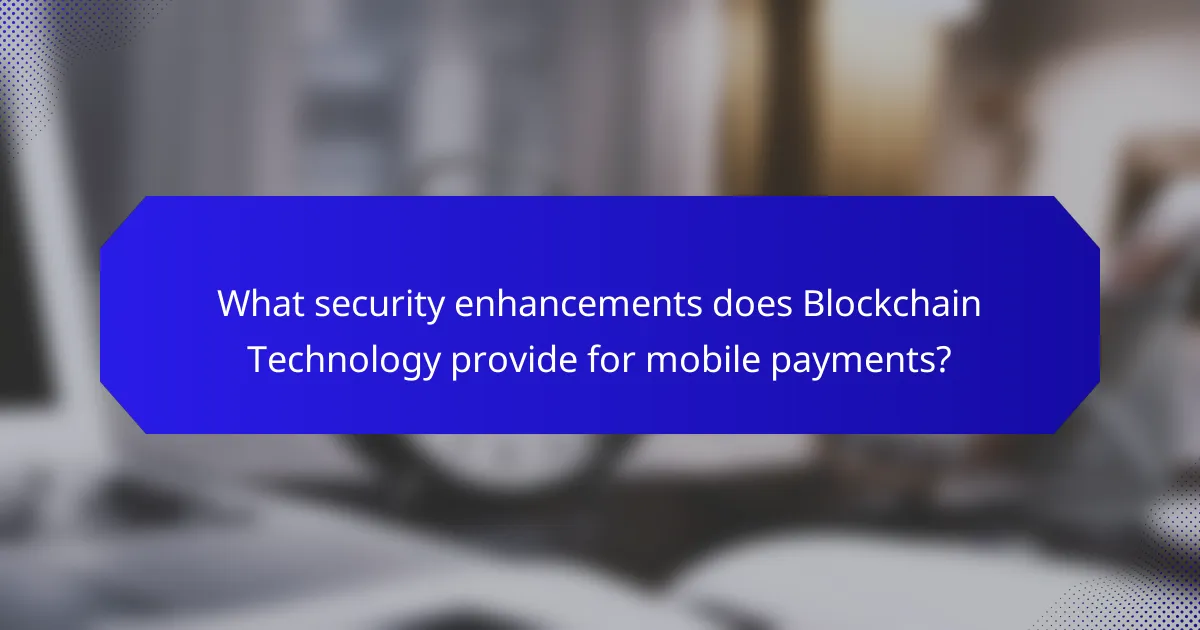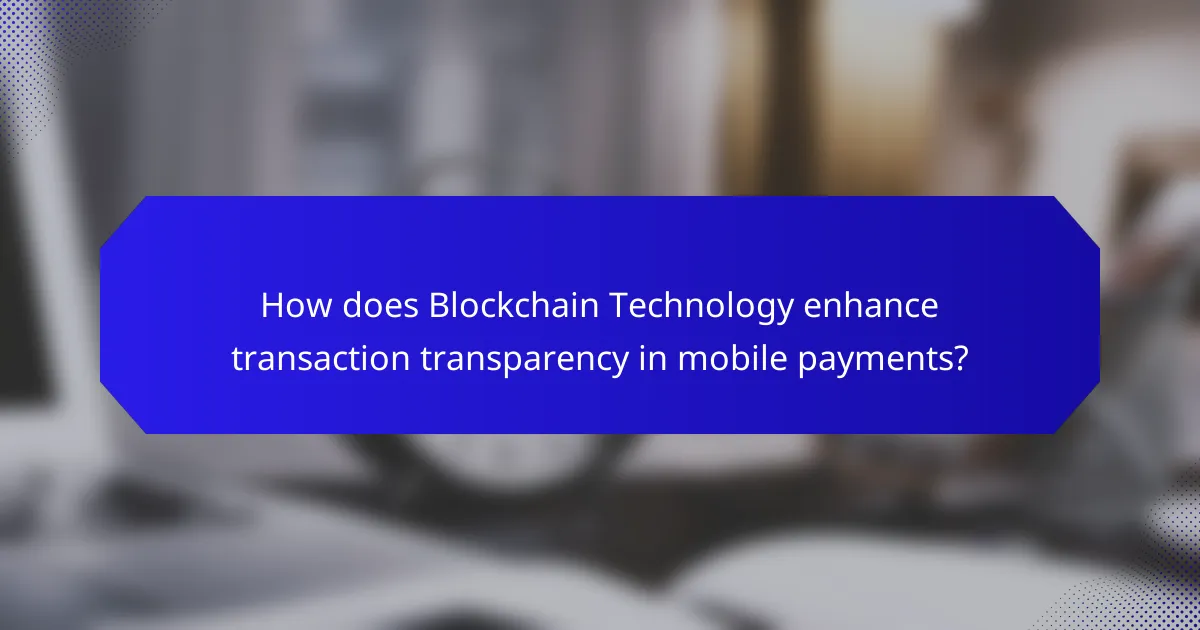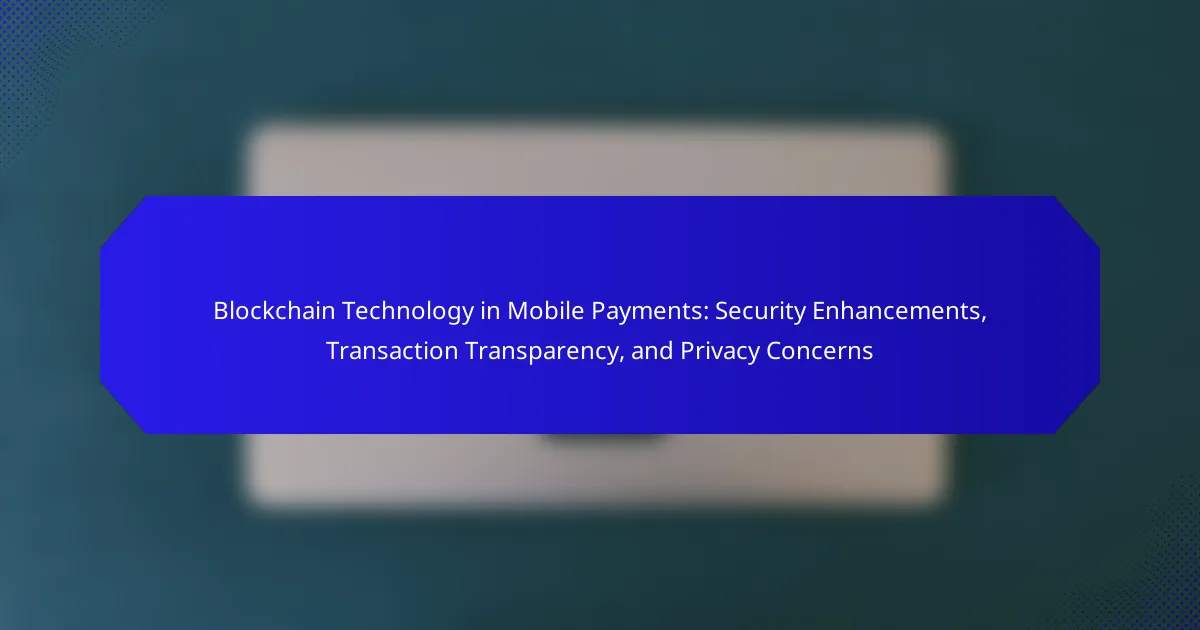Blockchain technology serves as a decentralized digital ledger system that enhances mobile payments by ensuring secure, transparent transactions without intermediaries. Key features of blockchain include immutability, which prevents alteration of transaction data, and encryption, which secures sensitive information during transmission. This technology significantly reduces transaction costs and fraud, with reports indicating potential reductions of up to 30% and 40%, respectively. Additionally, blockchain provides real-time transaction visibility, fostering trust and accountability among users. The article explores these security enhancements, transaction transparency, and associated privacy concerns within the realm of mobile payments.

What is Blockchain Technology in Mobile Payments?
Blockchain technology in mobile payments is a decentralized digital ledger system. It allows secure and transparent transactions between parties without intermediaries. Each transaction is recorded in a block and linked to previous blocks, forming a chain. This ensures that transaction data is immutable and cannot be altered retroactively. The use of cryptographic techniques enhances security against fraud. According to a report by McKinsey, blockchain can reduce transaction costs by up to 30%. Additionally, it provides real-time transaction visibility, increasing trust among users.
How does Blockchain Technology function in the context of mobile payments?
Blockchain technology functions in mobile payments by providing a decentralized ledger for transaction recording. Each transaction is encrypted and added to a block, ensuring security. This ledger is accessible to all participants, enhancing transparency. Transactions are verified through consensus mechanisms, reducing fraud risks. Smart contracts can automate payment processes, increasing efficiency. Blockchain’s immutability ensures that once a transaction is recorded, it cannot be altered. This technology also facilitates cross-border payments with lower fees and faster processing times. According to a report by PwC, blockchain can reduce transaction costs by up to 40%.
What are the key components of Blockchain Technology in mobile payments?
The key components of Blockchain Technology in mobile payments include decentralization, security, transparency, and immutability. Decentralization allows transactions to occur without a central authority, reducing the risk of fraud. Security is enhanced through cryptographic techniques, ensuring that transaction data is protected. Transparency is achieved as all transactions are recorded on a public ledger, making it easy to verify transactions. Immutability means that once a transaction is recorded, it cannot be altered, providing a reliable history of transactions. These components work together to enhance the overall integrity and efficiency of mobile payments.
How do these components enhance payment processes?
Blockchain technology enhances payment processes through increased security, improved transaction transparency, and enhanced privacy. Security is strengthened by cryptographic techniques that protect transaction data from unauthorized access. This reduces the risk of fraud and hacking incidents, which have plagued traditional payment systems. Transaction transparency allows all parties to verify transactions on a public ledger, ensuring accountability and reducing disputes. The immutable nature of blockchain records assures users that once a transaction is confirmed, it cannot be altered. Privacy is enhanced through pseudonymous transactions, allowing users to conduct payments without revealing their identities. This combination of security, transparency, and privacy makes blockchain a robust solution for mobile payment systems.
What are the primary benefits of using Blockchain Technology in mobile payments?
The primary benefits of using Blockchain Technology in mobile payments include enhanced security, increased transaction transparency, and improved efficiency. Blockchain technology utilizes cryptographic techniques to secure transactions, reducing the risk of fraud. According to a study by Accenture, blockchain can reduce payment fraud by up to 50%.
Increased transaction transparency allows all participants to view transaction history, promoting trust among users. A report from Deloitte indicates that 40% of financial institutions believe transparency will enhance customer trust in digital payments.
Finally, blockchain facilitates faster transactions by eliminating intermediaries, which can take days to process traditional payments. Research from the World Economic Forum shows that blockchain can enable real-time transactions, significantly reducing processing times.
How does Blockchain improve transaction security?
Blockchain improves transaction security through its decentralized and immutable nature. Each transaction is recorded in a block and linked to the previous block, creating a secure chain. This structure makes it extremely difficult for any single entity to alter transaction data. The use of cryptographic hashing ensures that any changes to a block would be evident. Additionally, consensus mechanisms like Proof of Work or Proof of Stake validate transactions before they are added to the blockchain. This collective agreement among nodes enhances trust and security. According to a report by the World Economic Forum, blockchain can reduce fraud and increase transaction integrity in financial systems.
What role does Blockchain play in transaction transparency?
Blockchain enhances transaction transparency by providing a decentralized, immutable ledger. Each transaction is recorded in a block and linked chronologically. This structure ensures that once data is added, it cannot be altered. Users can view transaction histories publicly, promoting accountability. The transparency of blockchain reduces fraud and increases trust among users. For example, Bitcoin’s ledger allows anyone to verify transactions without intermediaries. Studies show that blockchain’s transparency can lower transaction costs by eliminating the need for third-party verification.

What security enhancements does Blockchain Technology provide for mobile payments?
Blockchain technology enhances the security of mobile payments through decentralization, encryption, and immutability. Decentralization reduces the risk of a single point of failure. This means that transactions are not controlled by any single entity, making them less vulnerable to hacking. Encryption secures transaction data, ensuring that sensitive information is protected during transmission. Immutability ensures that once a transaction is recorded on the blockchain, it cannot be altered or deleted. This feature prevents fraud and unauthorized changes to transaction records. According to a 2020 report by Deloitte, blockchain can reduce fraud in mobile payments by up to 40%. These enhancements collectively create a more secure environment for mobile payment transactions.
How does Blockchain ensure data integrity and security?
Blockchain ensures data integrity and security through its decentralized and immutable nature. Each transaction is recorded in a block and linked to the previous block, forming a chain. This structure prevents unauthorized alterations. Once data is added to the blockchain, it cannot be changed without consensus from the network. Additionally, cryptographic hashing secures data, making it difficult to tamper with. Each block contains a unique hash of the previous block, ensuring continuity. The distributed network of nodes verifies transactions, enhancing security. This consensus mechanism reduces the risk of fraud and ensures transparency. As of 2023, blockchain technology is widely used in financial services, demonstrating its effectiveness in maintaining data integrity and security.
What cryptographic methods are used in Blockchain for securing transactions?
Blockchain secures transactions using cryptographic methods such as hashing, public-key cryptography, and digital signatures. Hashing converts transaction data into a fixed-size string of characters, ensuring data integrity. Public-key cryptography enables users to generate a pair of keys: a public key for receiving funds and a private key for signing transactions. Digital signatures authenticate transactions, confirming that the sender is legitimate. These methods collectively protect against fraud and unauthorized access. The SHA-256 hashing algorithm is commonly used in Bitcoin, ensuring secure and tamper-proof transactions.
How does decentralization contribute to security in mobile payments?
Decentralization enhances security in mobile payments by distributing data across multiple nodes. This reduces the risk of a single point of failure. In a decentralized system, data is not stored in one central location. Instead, it is replicated across various nodes in the network. This makes it more difficult for hackers to compromise the system.
Additionally, decentralization allows for greater transparency. Each transaction is recorded on a public ledger that cannot be altered. This transparency helps in detecting fraudulent activities. The use of cryptographic techniques in decentralized systems further secures transactions. These techniques ensure that only authorized users can access and approve transactions.
Research indicates that decentralized networks can reduce fraud by up to 80%. This is due to the increased difficulty for malicious actors to manipulate the system. Overall, decentralization significantly strengthens the security framework of mobile payment systems.
What are the potential vulnerabilities associated with Blockchain in mobile payments?
Potential vulnerabilities associated with Blockchain in mobile payments include security risks, scalability issues, and regulatory challenges. Security risks arise from private key management. If users lose their keys or fall victim to phishing attacks, they may lose access to their funds. Scalability issues can lead to slow transaction processing times during high demand. This can frustrate users and deter adoption. Regulatory challenges involve navigating complex legal frameworks. Different jurisdictions may impose varying requirements on blockchain technologies. Additionally, the immutability of blockchain can complicate dispute resolution. Once a transaction is recorded, it cannot be easily altered or reversed. These vulnerabilities can undermine user trust and hinder the growth of blockchain in mobile payments.
How can these vulnerabilities impact users and transactions?
Vulnerabilities in blockchain technology can significantly impact users and transactions. These weaknesses may lead to unauthorized access to sensitive information. Users can experience financial loss if their wallets are compromised. Transactions may be altered or reversed, undermining trust in the system. Additionally, vulnerabilities can expose personal data, leading to privacy breaches. According to a report by Chainalysis, over $1.9 billion was lost to cryptocurrency theft in 2020. This statistic highlights the real-world consequences of such vulnerabilities on users and transactions.
What measures can be taken to mitigate these vulnerabilities?
Implementing encryption is essential to mitigate vulnerabilities in blockchain technology for mobile payments. Strong encryption protects sensitive data from unauthorized access. Regular software updates can also address security flaws. These updates ensure that the system remains resilient against emerging threats.
Utilizing multi-signature wallets adds another layer of security. This requires multiple approvals for transactions, reducing the risk of fraud. Additionally, conducting regular security audits helps identify and rectify vulnerabilities proactively.
Educating users about safe practices is crucial. Awareness of phishing attacks and secure password management can significantly reduce risks. According to a report by the International Journal of Information Management, user education can reduce security breaches by up to 80%.
By combining these measures, the security of blockchain technology in mobile payments can be substantially enhanced.

How does Blockchain Technology enhance transaction transparency in mobile payments?
Blockchain technology enhances transaction transparency in mobile payments by providing a decentralized ledger that records all transactions. Each transaction is time-stamped and linked to previous transactions, creating an immutable record. This transparency allows users to verify transaction histories independently. Additionally, the use of cryptographic hashes ensures that transaction data cannot be altered without detection. According to a report by Deloitte, blockchain can reduce fraud and increase trust in mobile payment systems. This technology enables real-time visibility into transactions for all parties involved, fostering accountability.
What is the significance of transparency in mobile payment systems?
Transparency in mobile payment systems is crucial for building trust among users. It allows consumers to see transaction details, including fees and processing times. This visibility helps users understand the costs involved in their transactions. Furthermore, transparency can reduce the risk of fraud by providing a clear audit trail. According to a study by McKinsey, 70% of consumers prefer payment systems that offer clear transaction information. Enhanced transparency also fosters accountability among service providers. This accountability can lead to better customer service and improved user experiences. Overall, transparency is essential for the integrity and reliability of mobile payment systems.
How does Blockchain facilitate real-time transaction tracking?
Blockchain facilitates real-time transaction tracking through its decentralized ledger technology. Each transaction is recorded in a block that is linked to previous blocks, forming a chain. This structure allows for transparency, as all participants can view transaction histories. The use of cryptographic hashes ensures the integrity of the data. Each transaction is time-stamped and immutable, meaning it cannot be altered once confirmed. This feature enhances trust among users. Furthermore, consensus mechanisms validate transactions, ensuring they are legitimate before being added to the ledger. As a result, users can track transactions in real-time, enhancing efficiency and reducing fraud.
What advantages does transparency offer to consumers and businesses?
Transparency offers several advantages to consumers and businesses. It builds trust between parties. Consumers are more likely to engage with brands that demonstrate openness. Businesses can enhance their reputation through transparent practices. Transparency also leads to better decision-making for consumers. Informed choices result from clear information about products and services. For businesses, transparency can reduce risks associated with fraud. Studies show that companies with transparent practices often experience higher customer loyalty. Overall, transparency fosters a healthier marketplace for both consumers and businesses.
What privacy concerns arise from using Blockchain in mobile payments?
Blockchain in mobile payments raises significant privacy concerns. Transactions are recorded on a public ledger, making them visible to anyone. This transparency can lead to the identification of users and their transaction histories. Users may inadvertently expose sensitive financial information. Additionally, the immutability of blockchain means that once data is recorded, it cannot be altered or deleted. This permanence can create issues if personal information is mistakenly included in transactions. Furthermore, the use of public keys can sometimes be traced back to users, compromising anonymity. These factors highlight the need for enhanced privacy measures in blockchain mobile payment systems.
How does Blockchain handle user data privacy?
Blockchain handles user data privacy through decentralization and cryptographic techniques. User data is stored across a network of nodes, reducing the risk of centralized data breaches. Each transaction is encrypted and linked to a unique cryptographic hash. This ensures that user identities remain pseudonymous. Only the transaction details are recorded on the blockchain, not personal information. Access to data is controlled through private keys, which users manage themselves. This control enhances privacy, as only authorized parties can view the data. The immutability of blockchain records also prevents unauthorized alterations. Overall, these features collectively strengthen user data privacy in blockchain systems.
What are the implications of transparency on user privacy?
Transparency in blockchain technology can significantly impact user privacy. It allows for open access to transaction data, which can expose user identities and transaction histories. This visibility can lead to potential misuse of information by malicious actors. Additionally, while transparency promotes trust in the system, it may conflict with the need for anonymity in financial transactions. Studies indicate that increased transparency can deter fraudulent activities but also raises concerns about the protection of personal data. The balance between transparency and privacy is crucial for user trust in blockchain systems.
What best practices should users follow when using Blockchain for mobile payments?
Users should follow several best practices when using Blockchain for mobile payments. First, they must ensure their digital wallets are secure. This includes using strong passwords and enabling two-factor authentication. Users should also keep their software updated to protect against vulnerabilities. It is essential to verify the legitimacy of the blockchain platform before making transactions. Additionally, users should be cautious about sharing personal information. They should only transact with trusted parties to reduce the risk of fraud. Regularly monitoring transaction history can help users detect any unauthorized activity. Finally, users should educate themselves about blockchain technology to make informed decisions. These practices enhance security and promote safe mobile payment experiences.
Blockchain technology serves as a decentralized digital ledger system that enhances mobile payments through improved security, transaction transparency, and user privacy. The article examines how blockchain functions in mobile payments, detailing its key components such as decentralization, immutability, and encryption, which collectively reduce fraud and enhance trust among users. Additionally, it highlights potential vulnerabilities and privacy concerns associated with blockchain, emphasizing the importance of balancing transparency with user anonymity. The discussion includes best practices for users to ensure secure and efficient mobile payment experiences.
